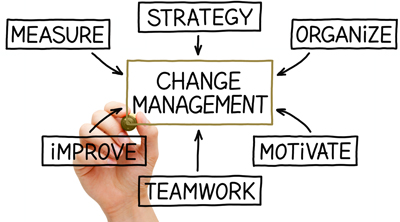Change Management | Emotional Intelligence
Making Organization Change Happen Effectively
 Change management sometimes is a scapegoat for less than stellar results: “That failed because we didn’t focus enough on change management.” And it’s often used as a catch-all for project activities that might otherwise get overlooked: “When we implement that new process, let’s not forget about the change management.”
Change management sometimes is a scapegoat for less than stellar results: “That failed because we didn’t focus enough on change management.” And it’s often used as a catch-all for project activities that might otherwise get overlooked: “When we implement that new process, let’s not forget about the change management.”
It’s a noun: “Change management is key to the project.” It’s a verb: “We really need to change manage that process.” It’s an adjective: “My change management skills are improving.” But what exactly is it?
Change management is a structured approach for ensuring that changes are thoroughly and smoothly implemented, and that the lasting benefits of change are achieved.
The focus is on the wider impacts of change, particularly on people and how they, as individuals and teams, move from the current situation to the new one. The change in question could range from a simple process change, to major changes in policy or strategy needed if the organization is to achieve its potential.
Understanding Change Management
Theories about how organizations change draw on many disciplines, from psychology and behavioral science, through to engineering and systems thinking. The underlying principle is that change does not happen in isolation – it impacts the whole organization (system) around it, and all the people touched by it.
In order to manage change successfully, it is therefore necessary to attend to the wider impacts of the changes. As well as considering the tangible impacts of change, it’s important to consider the personal impact on those affected, and their journey towards working and behaving in new ways to support the change. The change curve is a useful model that describes the personal and organizational process of change in more detail.
Change management is, therefore, a very broad field, and approaches to managing change vary widely, from organization to organization and from project to project. Many organizations and consultants subscribe to formal change management methodologies. These provide toolkits, checklists and outline plans of what needs to be done to manage changes successfully.
When you are tasked with “managing change” (irrespective of whether or not you subscribe to a particular change management approach), the first question to consider is what change management actually means in your situation. Change management focuses on people, and is about ensuring change is thoroughly, smoothly and lastingly implemented. And to know what that means exactly in your situation, you must dig down further to define your specific change management objectives.
Typically, these will cover :
- Sponsorship: Ensuring there is active sponsorship for the change at a senior executive level within the organization, and engaging this sponsorship to achieve the desired results.
- Buy-in: Gaining buy-in for the changes from those involved and affected, directly or indirectly.
- Involvement: Involving the right people in the design and implementation of changes, to make sure the right changes are made.
- Impact: Assessing and addressing how the changes will affect people.
- Communication: Telling everyone who’s affected about the changes.
- Readiness: Getting people ready to adapt to the changes, by ensuring they have the right information, training and help.
Who’s Responsible?
When you are defining your objectives and activities, it’s very important to coordinate closely with others: project managers, managers in the business, and the HR department. Ask “who’s responsible?” For example, who’s responsible for identifying change agents? Defining the re-training plan? Changing job descriptions and employment contracts? And so on.
As every change is different, responsibilities will vary depending on how the change activities and project are organized. Only when you know who’s responsible and how things are organized in your situation will you know what’s within your scope, and how you’ll be working with other people to bring about the change.
Change Management Activities
Once you have considered the change management objectives and scope, you’ll also need to consider the specific tasks. Again, the range of possible activities is broad. It’s a question of working out what will best help you meet the change challenge in hand, as you have defined it in your objectives and scope, and how to work along side other people’s and projects’ activities and responsibilities.
The essence of this is to identify the tasks that are necessary if you’re going to give change the greatest chance of success.
Coming from this, the activities involved in managing change can include:
- Ensuring there is clear expression of the reasons for change, and helping the sponsor communicate this.
- Identifying “change agents” and other people who need to be involved in specific change activities, such as design, testing, and problem solving, and who can then act as ambassadors for change.
- Assessing all the stakeholders and defining the nature of sponsorship, involvement and communication that will be required.
- Planning the involvement and project activities of the change sponsor(s).
- Planning how and when the changes will be communicated, and organizing and/or delivering the communications messages.
- Assessing the impact of the changes on people and the organization’s structure.
- Planning activities needed to address the impacts of the change.
- Ensuring that people involved and affected by the change understand the process change.
- Making sure those involved or affected have help and support during times of uncertainty and upheaval.
- Assessing training needs driven by the change, and planning when and how this will be implemented.
- Identifying and agreeing the success indicators for change, and ensure they are regularly measured and reported on.
To inquire about setting up customized training, contact us at: Training@GreenPowerGuy.com

